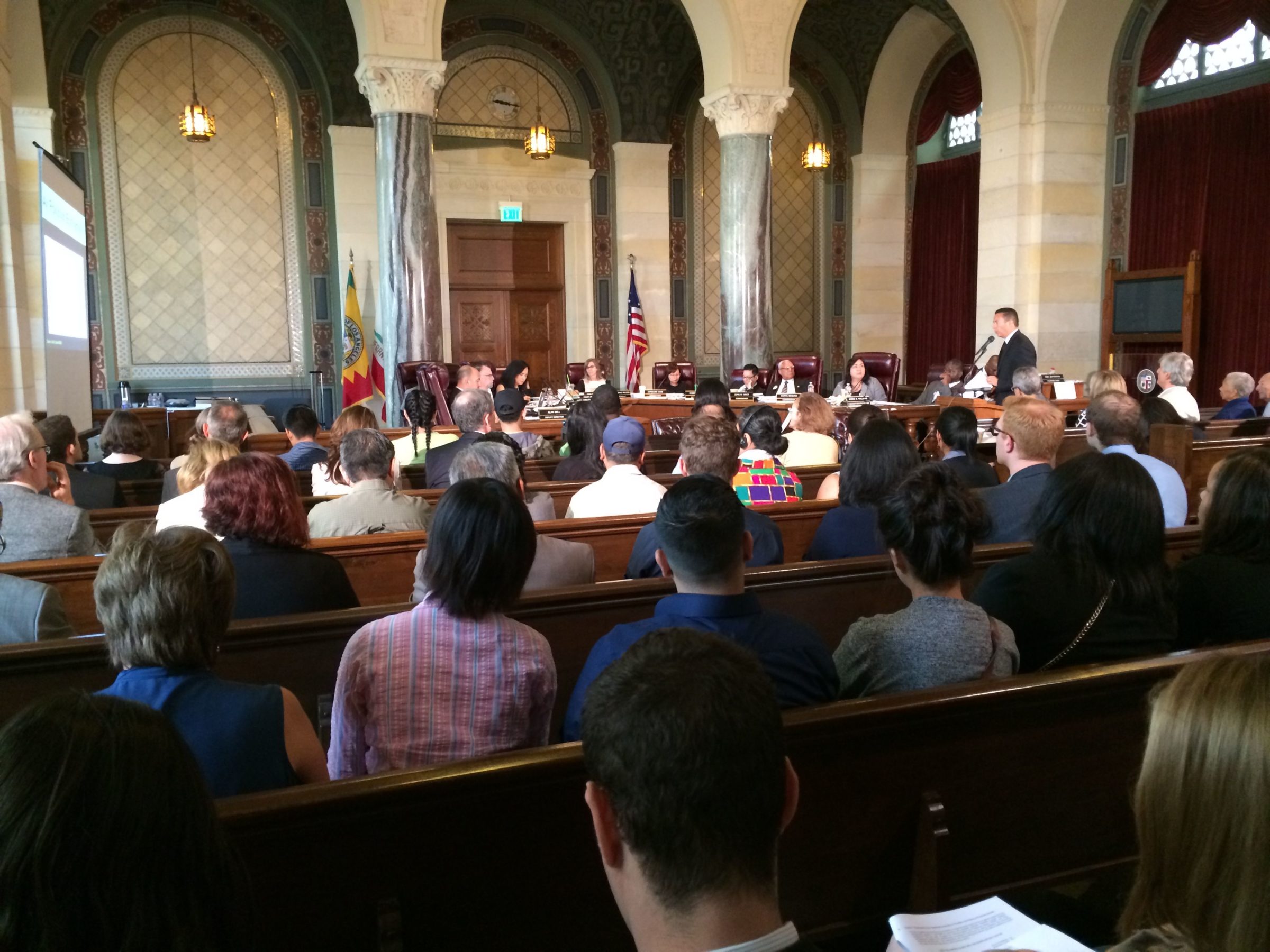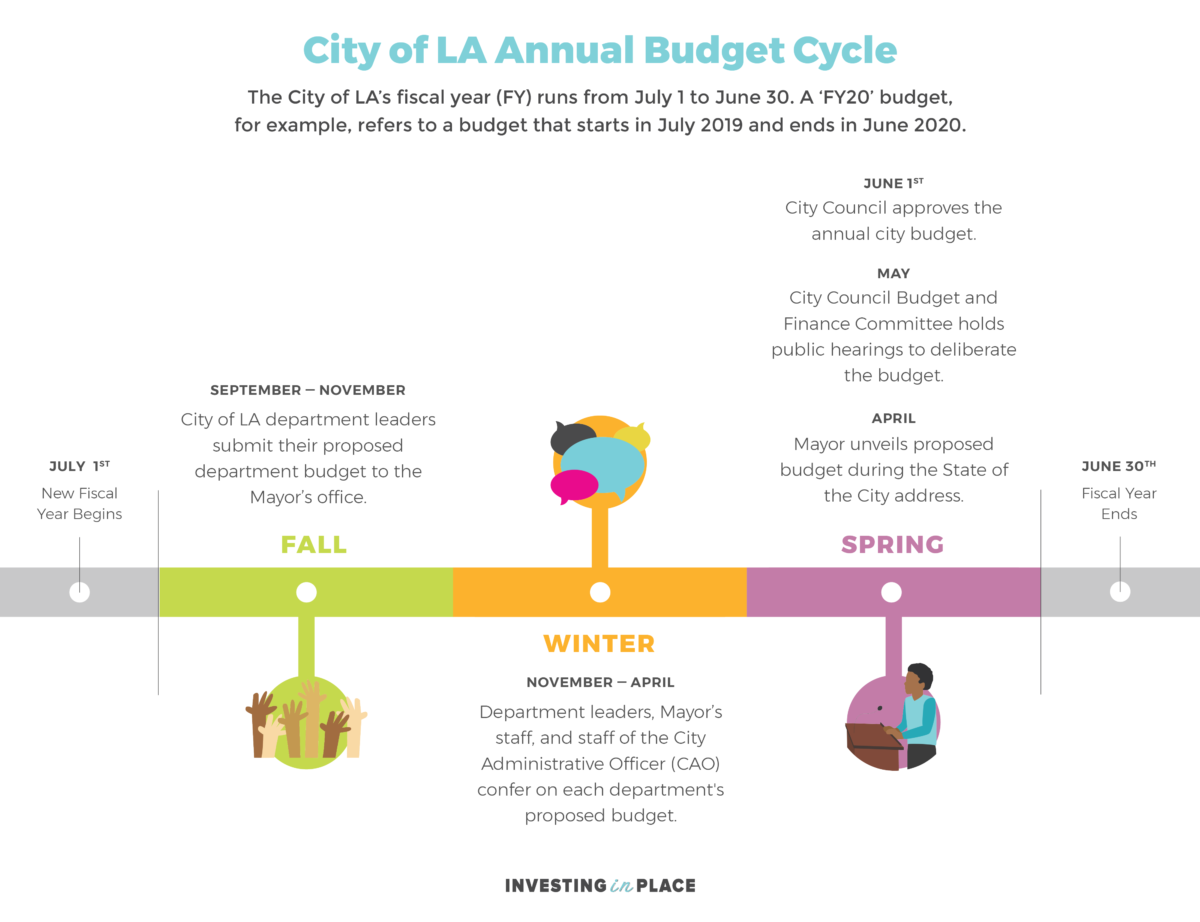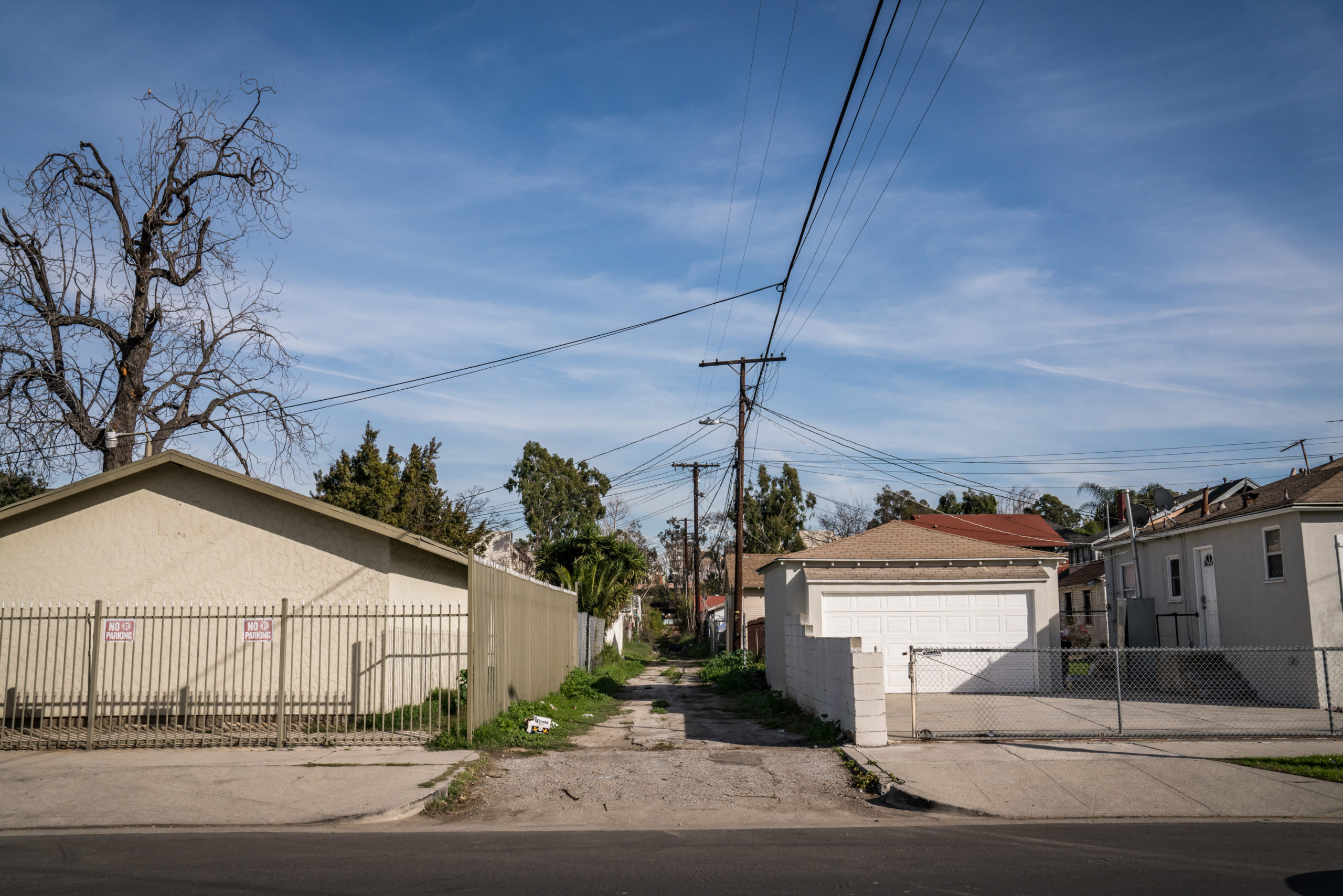Ever wonder why so many sidewalks in LA are broken, narrow, or missing altogether? Decades of government funding choices that have not prioritized the public right-of-way (sidewalks plus road space) underlie the issue (watch this). Ever wonder how to improve your local parks or libraries or street lights? When constituents earnestly call on their elected officials to step-up a specific public service or to fix broken infrastructure (including sidewalks), we hear public officials tell their constituents: “if it’s not in the budget, we can’t do it.” While budget allocations don’t always directly lead to real-time repairs, how cities decide to spend their annual budget does directly impact what residents and stakeholders can expect from their local government. In this way, the city’s annual budget reflects the city’s priorities for the upcoming fiscal year and highlights the boundaries of what city officials collectively believe they can accomplish.
City of LA Budget 101
The City of LA starts its fiscal year on July 1 and ends its fiscal year 12-months later on June 30. The City of LA’s annual budget, which the LA City Council and Mayor officially adopt in June, serves as the city’s spending and revenue plan for the upcoming fiscal year. A ‘FY20’ budget, for example, refers to a budget that starts in July 2019 and ends in June 2020.
The LA City Council is only one legislative body in the city to contribute to the budget, albeit the only body that deliberates budgets in a manner that is visible to the public. City department staff and staff representing the LA Mayor substantially contribute to the earliest iterations of the city’s budget before city councilmembers host their budget deliberations. By the time the City of LA’s 15 Councilmembers deliberate budget allocations in the spring, city department heads and staff representing the mayor’s office have already shaped the budget for several months.
Here’s a rough timeline showing how the City of LA budget is created and passed every year.
-
- September to November: City department heads coordinate with Mayor’s staff — Each City of LA department estimates the total amount of funds they need for salaries and wages for their department’s staff, plus new and ongoing initiatives assigned to that department. Then each department General Manager sends to the Mayor’s office staff a proposed annual department budget.
- November to April: City department heads deliberate with Mayor’s staff — City of LA department General Managers meet with Mayor’s office staff and the City Administrative Officer (CAO) to review their department’s proposed budget. The CAO is the financial advisor to the Mayor and City Council and assists in the preparation and administration of the city budget each year. These discussions form the foundation of the Mayor’s annual proposed budget and occur privately, outside the purview of the general public.
- April: LA City Mayor’s State of the City address — At this annual public event, the Mayor of Los Angeles outlines the city’s priorities for the upcoming fiscal year and unveils the Mayor’s proposed budget. This address sets in motion the public-facing segment of city budget deliberations.
- May: LA City Council Committee budget deliberations — LA City Council’s 5-member Budget and Finance committee hosts public hearings on the proposed budget for each of the city’s departments, which include the LA Department of Transportation and the LA Department of Public Works, for example. These hearings are hosted at City Hall and members of the public may attend, listen, and give timed public comment on any of the agenda items. The Budget and Finance committee chairperson has authority to schedule these hearings, determine the agendas, and set the allotted time for public comment. Agendas for these public hearings will list which department budgets will be reviewed. State law requires the city to publish agendas no less than 72 hours before each hearing.
- June: LA City Council budget approval — LA City Council’s 15-member legislative body reviews the budget and adopts the budget by June 1. The new fiscal year starts on the first of July.
How can I get involved?
When engaging with any city’s policy, legislative, or budget process we recommend three basic steps:
1) Relationships are everything
Anyone who wishes to shape the city’s budget in a meaningful way might consider cultivating relationships at multiple levels within city government. Principle players who most influence the City of LA budget include: staff representing department general managers, staff from policy and budget teams of Office of the LA Mayor, and the five city councilmembers who serve on the LA City Council Budget and Finance committee.
(Important to note! While you may live in a district of a councilmember who is not on the Budget and Finance committee, as a member of the public you can still engage with other council offices on issues covered by the committees they sit on.)
2) Know your issues
If you wish to strengthen your “asks” to city officials to deliver a public service or infrastructure, consider accompanying your requests with recommended allocation of resources. Some questions you might study ahead of the ask might include: With what funds could the city pay for the initial ask? Who would maintain the service or infrastructure after it is launched? If the city should maintain any new infrastructure, then how will the city pay to maintain its upkeep? Have any other cities done something similar to what you are requesting? Anyone can rely on relationships during city budgeting and a working knowledge of public finance to strengthen their asks.
3) Show, more than tell
Our elected officials understand that they are representatives. When members of the public can demonstrate huge support or opposition to an issue, our policymakers are more likely to listen. Anyone can show that they represent the interests of many constituents through sign-on letters, large groups at public hearings, widespread social media campaigns, and other methods. We find that the most effective advocacy is to combine individual relationships with city officials with public shows of vast support.
What’s the possible impact? A Vision Zero case study
City of LA officials tout a $9.9 billion budget for the fiscal year ending June 2019. This massive city budget breaks down into numerous departmental budgets. Departmental budgets break down further to fund specific initiatives, such as the initiative to save lives that end in traffic crashes, referred to as Vision Zero.
Prioritization — In 2015, LA Mayor Eric Garcetti launched the Vision Zero initiative in Los Angeles. In response, the City of LA’s transportation department (LADOT) developed long-term Vision Zero planning documents that chart out a course to eliminate traffic deaths in LA by 2025 while pointing out the forbidding reality of streets in LA where “motor vehicle crashes are the leading cause of death of children between the ages of 5 and 14” (LADOT, 2017, p. 18).
Investment — During the city’s budgeting process, Vision Zero advocates and supportive elected officials leveraged LADOT-published planning documents to raise the spectre of funding for Vision Zero from $3 million to $27 million in FY18. This show of support was also influential to continue increases to Vision Zero funding to $37 million in FY19 — a 1,100% budget increase in three years. While this upward trending financial commitment to road safety is encouraging to every road user, physical changes to streets saves lives.
Implementation — So far, some of the City of LA’s most visible Vision Zero accomplishments have included installing diagonal crosswalks in Hollywood (2015), MacArthur Park (2017), and Venice (2018) — an intersection design type that studies show cuts pedestrian collisions by half. Based on a Vision Zero screening of streets for exceedingly high* occurrence of human fatality and injury, city officials have begun reshaping parts of Reseda Blvd. in the West San Fernando Valley, Roscoe Blvd. in the East San Fernando Valley, and five other Complete Street corridors whose present street conditions have often resulted in human tragedy.
* Vision Zero initiatives promote the notion that traffic crashes are entirely preventable and declare any human fatality by traffic crash as unacceptable.
City budgets reflect the city’s priorities for the upcoming fiscal year and highlight the boundaries of what city officials believe they can accomplish together. In order to influence public spending at the City of LA in a meaningful way, advocates can start by cultivating relationships at multiple levels of city government; matching their asks to city officials with funding source recommendations and proposed budgets; and showing support at budget hearings by building partnerships among allies and testifying at public hearings in the spring. The city’s budget cycle is active nearly all year round — starting with department managers and Mayor’s staff deliberations in the fall and ending with a City Council vote and Mayor approval in the spring (June 1). Once your desired initiatives appear in the budget, you and supporters can strengthen your appeal for change.













You must be logged in to post a comment.